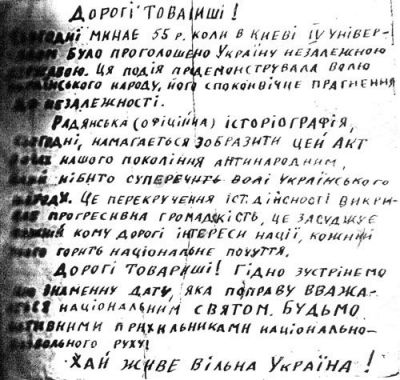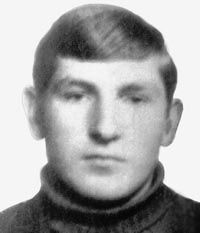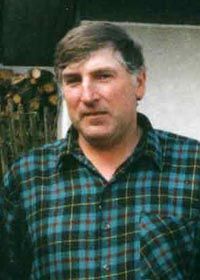(born July 15, 1956, in the village of Rosokhach, Chortkiv raion, Ternopil oblast)
A member of the Rosokhach youth national-patriotic underground organization.
The youngest of five children in a peasant family. In 1971, he completed 8th grade at the Rosokhach school. He was interested in the history of the Ukrainian people, admired the struggle of the UPA for independence, listened to foreign radio stations, and read and discussed patriotic literature with his friends. He was friends with an older relative, Volodymyr MARMUS, and belonged to a circle of patriotically minded fellow villagers who were outraged by the destruction of memorial crosses and the grave of the Sich Riflemen in the village, as well as the demolition of the church. The 1972 arrests of the Ukrainian intelligentsia spurred the young men to create an underground organization in the autumn of that year, with the goal of fighting for independence.
Even before the organization was formally established, in late October 1972, V. and Volodymyr SENKIV damaged a monument to the “Soviet soldier-liberator” with an axe—in retaliation for the destruction of the grave of the Sich Riflemen, which had been erected by villagers in 1941. He had a sawn-off rifle (obriz) and practiced shooting in the forest with V. MARMUS.
On November 5, 1972, in a forest clearing where UPA partisans had previously stopped, in a solemn ceremony—with candles, kneeling before a cross and an icon of the Mother of God—V. MARMUS, V., V. SENKIV, and Petro VYNNACHUK took an oath of allegiance to Ukraine.

In February 1973, the arrests began. V. was detained by the KGB on April 11, 1973. He had to confess his actions and surrendered his hidden weapon. He was released from custody a week later after signing a pledge not to leave. As V. was a minor, the initiation of a criminal case against him was denied. For a year, KGB agents unsuccessfully tried to persuade him into secret cooperation.
He traveled to work in the eastern oblasts of Ukraine and graduated from a driving school. From 1974 to 1976, he served in the Soviet Army in Zhytomyr, and later in Poltava. He was a commander’s driver. There, too, officers from the special department tried to recruit V., but he stubbornly refused.
After returning from the army, he worked as a driver. He is married to Pavlyna Synyshyn; they have daughters, Maria (b. 1975) and Ivanna (b. 1977), and a son, Volodymyr (b. 1979, named in honor of V. MARMUS).
He was a member of the Ukrainian Republican Party. He lives in the village of Rosokhach.
By a Presidential Decree of August 18, 2006, V. was awarded the Order “For Courage,” 1st Class.
Bibliography:
Report note of the Central Committee of the Communist Party of Ukraine to the Central Committee of the CPSU on the activities of nationalist groups in the Ivano-Frankivsk, Lviv, and Ternopil oblasts of Ukraine. September 27, 1973. – *Natsionalni vidnosyny v Ukraini XX st.* (National Relations in Ukraine in the 20th Century). Kyiv: Naukova Dumka, 1994. Pp. 418-420.
Georgiy Kasyanov. Nezghodni: ukrainska intelihentsiia v rusi oporu 1960-1980-kh rokiv (The Dissenters: The Ukrainian Intelligentsia in the Resistance Movement of the 1960s–1980s). Kyiv: Lybid, 1995. P. 142.
Volodymyr Marmus. “Prapory nad mistom” (Flags Over the City). Ternystyi shliakh (Ternopil). 1998, No. 3 (323). January 9; Molod Ukrainy. 1998, No. 7 (17638). January 22.
Anatoliy Rusnachenko. Natsionalno-vyzvolnyi rukh v Ukraini (The National Liberation Movement in Ukraine). Kyiv: Vydavnytstvo im. O. Telihy, 1998. P. 208.
Andriy Vatsyk. “Tsinoiu vlasnoi svobody” (At the Price of One’s Own Freedom). Ternopilska hazeta. 1999, No. 4 (160). January 21.
KHPG Archives (Interview with Petro Vitiv, his brother Stepan, and mother Maria on April 3, 2000). https://museum.khpg.org/1121168016
Iunaky z ohnennoi pechi (Youths from the Fiery Furnace). Kharkiv Human Rights Protection Group. Compiled by V. V. Ovsienko. Kharkiv: Folio, 2003. Pp. 104 – 110 et al.
Marmus, Volodymyr. Dolia obrala nas: Spohady, dokumenty, statti (Fate Chose Us: Memoirs, Documents, Articles). Ternopil: Printerinform, 2004. Pp. 76, 90, 92, 94-97, 100, 108, 116, 130-179.
Mizhnarodnyi biohrafichnyi slovnyk dysydentiv krain Tsentralnoi ta Skhidnoi Yevropy i kolyshnoho SRSR (International Biographical Dictionary of Dissidents in Central and Eastern Europe and the Former USSR). Vol. 1. Ukraine. Part 1. Kharkiv: Kharkiv Human Rights Protection Group; “Prava Liudyny,” 2006. Pp. 106–107. https://museum.khpg.org/1121002291
Rukh oporu v Ukraini: 1960 – 1990. Entsyklopedychnyi dovidnyk (The Resistance Movement in Ukraine: 1960 – 1990. An Encyclopedic Guide). Preface by Osyp Zinkevych, Oles Obertas. Kyiv: Smoloskyp, 2010. P. 116; 2nd ed.: 2012, Pp. 128–129.
“Fantaziie, ty sylo charivna! Vidkrytyi lyst dysydenta Ovsiienka dysydentu (i fantazeru) Sapeliaku” (Fantasy, You Are a Magical Force! An Open Letter from the Dissident Ovsienko to the Dissident (and Fantasist) Sapeliak): http://www.istpravda.com.ua/ukr/articles/2011/08/29/53451/, August 29, 2011.
V. Ovsienko. “Pravda staie istoriieiu” (Truth Becomes History): http://maidan.org.ua/2012/01/pravda-staje-istorijeyu/. January 29, 2012.
Vasyl Ovsienko, Kharkiv Human Rights Protection Group. December 12, 2002. Last read on August 3, 2016.
